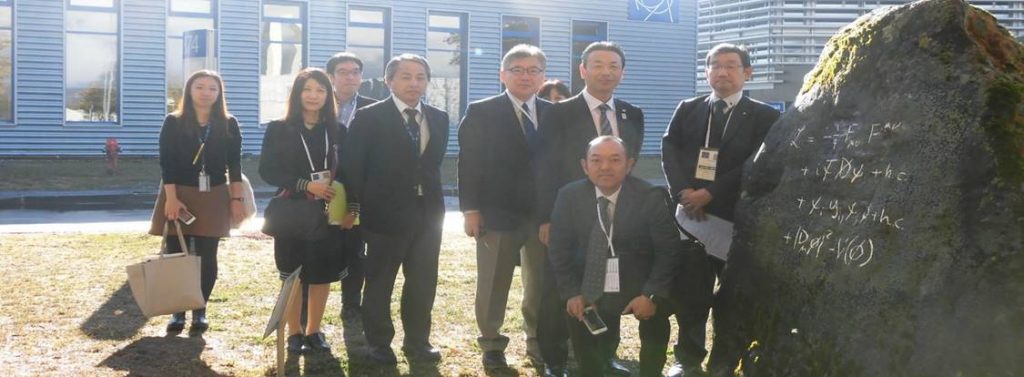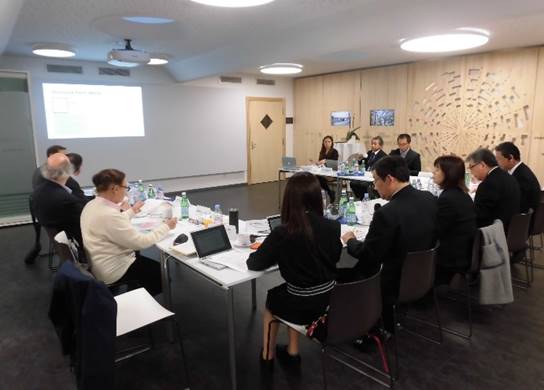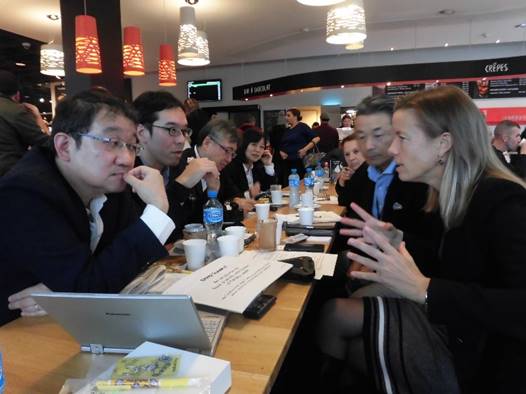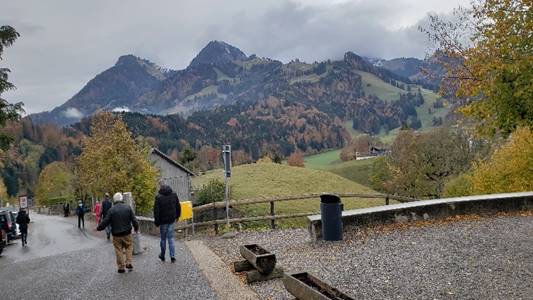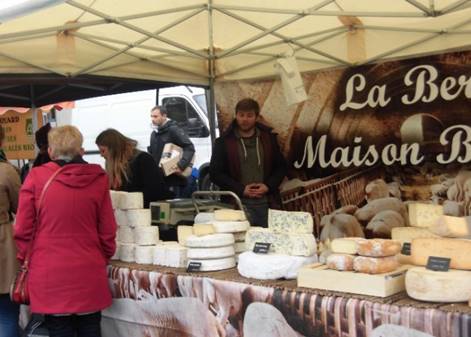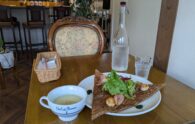Cover photo: Cjeiler from Wikipedia (Public domain)
If the ILC is realized, then researchers and their families will come here to Tohoku (northeast Japan) from all over the world. The local community will have to create not only a place for research, but also prepare hospitals, schools, and other things to be able to serve foreign residents. What sort of things should we do? There are a few things I personally am curious about: what types of foods to do researchers like (that you can’t get here)? What do they like to do on their days off? And how do we link that up with Tohoku businesses?
It’s questions like this that led members of the Tohoku ILC Promotion Council to travel to CERN and its surrounding area. There, they researched local support systems, as well as how CERN interacts with local governments, businesses, and people in the area.
First stop, CERN
At CERN, they have a Staff Association which supports scientists, technicians, and other staff that work directly for CERN. There is also a Users’ Support group that supports researchers, engineers, tourists, or any other type of visitor that belongs to other organizations. We had a discussion with representatives from both groups, along with the manager of a tourism agency located within CERN. First, the CERN-side shared information about their activities, and then they gave their comments on our presentation about Tohoku’s beautiful nature, rich history, and all the best food and tourism resources we have to offer. Through our discussion, we reaffirmed how important it was to be aware of diversity and multiculturalism when operating an international project.
Visiting Cailler
We also gave a presentation on Tohoku to Ms. Fleur Helmig, business manager at Swiss chocolate company Cailler. We were able to learn about how Cailler deals with doing business around the world – the difficulties they’ve had along with their strategies for overcoming them. We were able to get feedback so we can create strategies that Tohoku can use for the ILC, and to internationalize Tohoku businesses.
Ms.Helmig talked about Cailler’s successful marketing and promotion strategies, and we think this information will be vital for creating effective strategies to promote Tohoku’s cuisine and tourism.
Gruyère and Lavaux
Gruyère is a district around 2 hours away from Geneva, surrounded by beautiful nature like the Moléson mountain and the Lake of Gruyère. It’s a hilly region where people traditionally raised cattle. A town and castle remain from medieval times, and cheese produced here is famous world-wide. The pastures and mountains look a lot like scenery found in Tohoku.
They have distilled their rich nature, animal husbandry skills, and medieval history together into a popular, compact tourism district. I think there’s a lot Tohoku can learn from Gruyère.
Lavaux is around 1.5 hours away. It’s home to all these little villages where grape farmers live, and the area is renowned for its long tradition and history of making wine – in 2007, they were recognized by the World Heritage List. Lavaux doesn’t do anything special to develop itself as a tourist place – you won’t find souvenir shops here. It’s a good example of a place getting buzz with little effort on their part.
Ferney-Voltaire
We also visited the morning market in Ferney-Voltaire, a town near CERN on the France side. The morning market takes place in different towns every day, and on Saturdays it’s held in Ferney-Voltaire. The market is held from 8:00 am to around 1:00 pm, and you can buy a lot of the food items for a discount when it approaches closing time. We bought some things at around 11:30 that were more than half off. We also ran into people from CERN’s Users’ Support that we met earlier in the week.
Many CERN researchers live in Ferney-Voltaire (and so do researchers from KEK, Japan’s High Energy Accelerator Research Organization). We were able to see how many CERN staff get to live their daily lives.
Some comments from people on the trip
・At CERN, I felt they were very aware that teaching people of all ages and nationalities about CERN will leave a big impact on the future of the lab itself.
・The ILC is not just necessary for the business sector, but for NPOs and other civic sector projects.
・When not researching or working in the lab, many CERN staff enjoy the great outdoors in their spare time.
・In Tohoku, there is a long hiking trail spanning from Hachinohe (Aomori) to Soma (Fukushima) called the Michinoku Coastal Trail. This year, a hub information center will be created in Natori (Miyagi, mid-way through the trail). The center will be run by NPO Michinoku Coastal Trail. I think it will be important for us to utilize this trail and the NPO.
・I was able to see how big CERN was, and envision what a facility like this would look like for Tohoku. Even though there’s a lot of big buildings and structures at CERN, they have concentrated on blending it in with the surrounding town scenery.
・The vision for CERN is the ideal of Science for Peace and open-mindedness, and I was able to learn about that at their lab.
・A research lab brings benefits to its surrounding region that are bigger than we can imagine. It’s not just a framework for searching for new physics. The Users’ Office does so many things for the tens of thousands of people who visit to do research every year, from arranging accommodations to preparing their food.
What we’d like to think about for the future because of our trip
We’d like to work on the following things, using our trip to CERN and the examples in the surrounding area as our reference.
Promoting Tohoku’s Cuisine and Tourism
① Coming up with marketing strategies
- Demographics: Other than particle physicists coming for the ILC, what kind of people will live here, etc
- Targeting: Should we aim our efforts at particle physicists, how many services/what kind of services do we provide, should this be aimed at adults or at families, etc
- Positioning: Think about unique selling propositions ⇒ What are the strengths that Tohoku has over other regions? What things interest our target audience? etc
- Thinking about the best route to get here: Think about a tourism route that envisions the customer’s entire journey (including transportation and hotels), etc
- Think about promotion strategies on the web
② Coming up with multicultural content
- Don’t just use Tohoku’s strengths in our content – come up with products that take into account the different backgrounds of scientists coming if the ILC realized
Working towards internationalization (Come up with support systems)
① Deliberate on an organization that can respond to the needs of a multicultural society
If the ILC creates a Staff Association of some kind, it shouldn’t just be Japanese people on the board figuring out what kind of organization it will be. They need to include staff with knowledge of life abroad.
Japanese
食と観光の視点から、ILCの受入れ準備~東北ILC推進協議会 CERN視察から~
ILCが実現したら、世界中からやってくる研究者やその家族たち。研究環境だけでなく、日常生活、病院、学校...地元はどのような受入れ準備をしたらいいだろう?まず思い付いたのが、普段何を食べるだろう?休みの日はどこで何をするだろう?そして、私たちのビジネスにどのようにつながるだろうか?というものでした。
こうした発想から、CERNでのサポート体制やCERN周辺の自治体・企業・住民の関わり方について、2018.11.~3日にかけて、東北ILC推進協議会の会員企業5社の経営者と一緒にCERNやその周辺を訪ね、リサーチしました。
1.欧州原子核研究機構(CERN)
CERNの研究者や技術者など職員をサポートする「Staff Association」、CERN外部から訪れる研究者等(研究者、エンジニア、観光客含むビジター等)をサポートする「Users’Support」の両組織の代表、およびCERN内にオフィスを構える旅行代理店のマネージャー等と意見交換を実施した。はじめにCERN側の活動内容について紹介頂き、多文化共生に対応する取り組み状況などを説明頂いた。その後、東北ILC推進協議会から東北の美しい自然や歴史をはじめ、食や観光資源の魅力をプレゼンテーションし、感想やコメントを得た。意見交換を通して、国際プロジェクト運営における「多様性」や「多文化共生」への意識の重要性を改めて認識することができた。
2.カイエ( Cailler )
カイエ社のビジネスマネージャー(Ms.Fleur Helmig)に東北の魅力についてプレゼンテーションを行い、コメントを得るとともに、スイスの国際企業であるカイエにおいて、スイスから世界各地でビジネスを行う際の苦労や工夫、戦略など、ILC誘致に関連する東北の戦略や東北企業の国際化につながる知見を得るべく、意見を交わした。
Ms.Helmigより、カイエを例にして成功するマーケティング戦略・プロモーション戦略のポイントを説明頂き、今後、東北にとっても、食・観光においてしっかり戦略を立てて取り組む必要性を強く認識した。
3.CERN周辺地域視察
(1)グリュイエール(Gruyère)・ラヴォ―(Lavaux)
グリュイエールはジュネーブから約2時間の場所にあり、モレゾン山やグリュイエール湖など美しい自然に囲まれ、牧畜農家の伝統的な暮らしが息づく山里の観光地である。中世の町やお城が残り、周辺は牧童の暮らしと伝統が受け継がれており、特産のチーズの名前としても世界的に有名である。のどかな牧草地と山並みは、どこか東北の雰囲気にも似ている。
豊かな自然と牧畜、そして中世の歴史をコンパクトにまとめ魅力溢れた観光地として人気を博しているところは、東北としても参考にすべき点が多いと思った。
ラヴォーは、ジュネーブから約1時間30分。葡萄農家が暮らす小さな村が織り成す景観の美しさだけでなく、ワインづくりの長い伝統と歴史が評価され、2007年に世界文化遺産として登録された。ラヴォーは、土産物屋など、いわゆる観光地の作り込みは特にしていない。敢えて手つかずのままの姿が観光地として人気となる事例として参考となった。
(2)フェルネー ヴォルテール(Ferney-Voltaire)
CERNのフランス側にあるフェルネー・ヴォルテール村の朝市を訪問。朝市は、毎日場所を変えて開催しており、毎週土曜日はフェルネー・ヴォルテール村で行われている。朝市は8:00~13:00頃まで開かれ、終了近くになると食材等はディスカウントされていく。我々が11時半過ぎに購入した食材は、表示よりも1/2以上安い価格となっていた。また11月1日にお世話になったCERN Users’ Supportの方に偶然お会いした。
フェルネーにはCERNの研究者が多く住んでおり(KEKのスタッフも住んでいる)、CERNスタッフのライフスタイルを垣間見ることができた。
4.視察参加者のコメント(一部抜粋)
・あらゆる国のあらゆる世代にCERNを理解してもらうための工夫が、将来的な自分たちの研究環境整備に大きな意味を持つことを良く知っていると感じた。
・ILCは企業セクターだけではなく、NPOなど市民セクターも含めた活動にしていく必要があるだろう。
・研究や業務の時間以外では、それぞれがプライベートを楽しんでいるとのことで、アウトドアは人気とのこと。
・東北では、八戸から相馬までをつなぐ「みちのく潮風トレイル」というトレッキングコースがスタートし、今年中くらいに名取に拠点施設が完成する。この施設の運営はNPO法人みちのく潮風トレイルが行う・こういったトレッキングの環境・組織をうまく生かしていくことが重要。
・CERNの規模感を体感することができ、研究施設が地域にできることがイメージできた。施設はそれぞれ大規模だが、まちの景観にとけこむよう配慮されている。
・CERNの核になっている理念としての「Science for Peace」、「懐の広さ」について実際の研究所で学ぶことができた。
・研究施設が地域にもたらす貢献は、想像以上に大きい。「物理の探求」という枠組みだけではない。また年間数万人の研究に取り組む訪問者に対し、ユーザーズオフィスは、環境整備・食事の提供など多種多様なことを行う。
5.視察を踏まえた今後の検討事項
今回の視察を通じて把握したCERNや周辺地域の事例を参考に、今後、下記の事項に取り組んでいきます。
(1)東北の食・観光プロモーション
①マーケティング戦略の検討
●セグメンテーション:ILCを契機に素粒子物理学者以外でどんな人が居住するか等
●ターゲティング:素粒子物理学者に絞るか、その裾野(サービス関連等)までを含めるか、また大人向け
かファミリー向けか 等
●ポジショニング:「ユニーク・セリング・プロポジション」の検討
⇒ 他地域と比べ東北にしかない強みは何か。ターゲットにとって、特に魅力的なコンテンツは何か 等
●ルート・移動の検討:カスタマー・ジャーニーをイメージした観光ルートの検討、(移動手段・宿泊施設のイメージ含む) 等
●Webでのプロモーション戦略検討
②多文化共生型コンテンツの検討
●東北としての強みを活かしたコンテンツだけではなく、ILCがスタートした場合に居住する研究者の国籍を踏まえた商材の検討。
(2)国際化への対応(支える仕組みの検討)
①多文化共生に対応した組織の検討
ILCとして、Staff Associationのような組織を作る場合は、検討段階から日本人だけでなく、海外の知見を持つスタッフを入れることが重要である。

